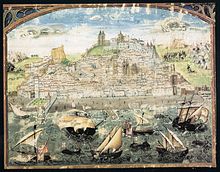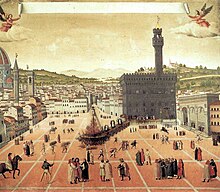天正遣欧少年使節

右上・伊東、右下・千々石、左上・中浦、左下・原。中央・メスキータ神父[1][2]。
天正遣欧少年使節(てんしょうけんおうしょうねんしせつ)は、1582年(天正10年)にキリシタン大名である大友義鎮(宗麟)・大村純忠・有馬晴信らの名代としてローマへ派遣された4名の少年を中心とした使節団である。天正遣欧使節、天正少年使節とも呼ぶ。イエズス会員アレッサンドロ・ヴァリニャーノが発案した。豊臣秀吉のバテレン追放令などで一時帰国できなくなるが、1590年(天正18年)に帰国。使節団によってヨーロッパの人々に日本の存在が知られるようになり、彼らの持ち帰ったグーテンベルク印刷機によって日本語書物の活版印刷が初めて行われキリシタン版と呼ばれた。
目的
[編集]ヴァリニャーノは自身の手紙の中で、使節の目的をこう説明している。
- 第一はローマ教皇とスペイン・ポルトガル両王に日本宣教の経済的・精神的援助を依頼すること。
- 第二は日本人にヨーロッパのキリスト教世界を見聞・体験させ、帰国後にその栄光、偉大さを少年達自ら語らせることにより、布教に役立てたいということであった。
研究者の伊川健二は、ヴァリニャーノを正使とした使節団がインドのゴアを中心に、日本からヨーロッパへの橋渡しをしたことを主張している。また彼らは、ヨーロッパへ渡りはじめて帰国した日本人とされる。渡欧し、現地に残ったものは、1555年のベルナルドなどが確認されている。
天正遣欧使節記
[編集]『天正遣欧使節記』または『遣欧使節対話録』として4名の少年達の生きた声として引用されているのが『デ・サンデ天正遣欧使節記』[3]だが、これは日本に帰国前の少年使節と日本にいた従兄弟の対話録として著述されており、両者の対話が不可能なことからフィクションとされている[4][5]。歴史学で使われる一次資料には大名または使節からの書簡[6][7]、各国使節の報告書簡[8]、会議録、会計帳簿等があり、これらを集めて分析した歴史学者の記録とは厳密に区別されており、『デ・サンデ天正遣欧使節記』に記述された少年たちの対話録や目撃証言は巡察師ヴァリニャーノが伝えようとした虚構と考えられている[4][注釈 1][5][注釈 2]。
使節団の構成
[編集]使節の少年たちは有馬晴信が日野江城下に建てたセミナリヨで学ぶ生徒の中から選ばれた。使節4名の正確な生年月日は不明だが、派遣当時の年齢は13 - 14歳であった。1568年2月生まれ(14歳)の中浦ジュリアンが最年長で、他の3人の生年は不明だが原マルティノが最年少と言われる。

- 使節
- 随員
- ジョルジェ・ロヨラ修道士 - 使節の教育係、日本人
- コンスタンチノ・ドラード - 印刷技術習得要員、日本人少年
- アグスチーノ - 印刷技術習得要員、日本人少年
- アレッサンドロ・ヴァリニャーノ神父 - ローマへ随行するつもりだったが、職務によってゴアにとどまる。
- ヌーノ・ロドリゲス神父 - ヴァリニャーノの後を継いで一行に従う。
- ディオゴ・デ・メスキータ神父 - 通訳、イエズス会員
- ロレンソ・メシア神父
- オリヴィエーロ修道士
主な寄港地・宿泊地
[編集]- マカオ
- マラッカ
- コチン (インド)
- サンタ・エレーナ (セントヘレナ島)
- リスボン
- グアダルーペ (これよりスペイン)
- トレド
- マドリード
- ベルモンテ
- ムルシア
- アリカンテ
- マヨルカ島
- ピサ (これよりイタリア)
- フィレンツェ
- シエナ
- ローマ
- ボローニャ
- ヴェネツィア
- フェラーラ
- ミラノ
- ジェノバ
- バルセロナ (これよりスペイン)
- モンセラート
- サラゴサ
- マドリード
- コインブラ (これよりポルトガル)
- シントラ
- リスボン
- モザンビーク島
- ゴア (インド)
- マラッカ
- マカオ
関係年譜
[編集]

- 1582年(天正10年)
- 1583年12月20日(天正11年旧暦11月7日) - マラッカ・コチンをへてゴア着。
- 1584年(天正12年)
- 1585年(天正13年)
- 3月1日(旧暦1月30日) - スペインのマヨルカ島を経由しイタリアのリヴォルノに到着、トスカーナ大公国に入る。イタリアの地を初めて踏む。
- 3月2日(旧暦2月1日) - 午後1時にピサに到着。ピサ宮殿にてトスカーナ大公フランチェスコ1世・デ・メディチに謁見。その晩、大公妃ビアンカ・カッペッロ主催の舞踏会に参加。ピサ滞在中、斜塔や大聖堂をはじめとするピサのドゥオモ広場を訪れる。
- 3月6日(旧暦2月5日) - カヴァリエーリ広場にあるサント・ステファノ・デイ・カヴァリエーリ教会にて聖ステファノ騎士団を見学する。この日は四旬節の初日である灰の水曜日であったため、トスカーナ大公とともに灰を受ける。
- 3月7日(旧暦2月6日) - フィレンツェに到着。シニョリーア広場にあるヴェッキオ宮殿に宿泊する。
- 3月11日(旧暦2月10日) - フィレンツェ近郊にある別荘ヴィッラ・デミドフ(ヴィッラ・プラトリーノ)で過ごす。
- 3月23日(旧暦2月22日) - ローマでローマ教皇グレゴリウス13世に謁見。ローマ市民権を与えられる。
- 5月1日(旧暦4月2日) - グレゴリウス13世の後を継いだシクストゥス5世の戴冠式に出席。
- 6月3日(旧暦5月6日) - ローマを出発。以後ヴェネツィア、ヴェローナ、ミラノなどの諸都市を訪問。途中、アッシジにも巡礼。
- 1586年4月13日(天正14年旧暦2月25日) - リスボンを出発。帰路につく。
- 1587年(天正15年)
- 1590年7月21日(天正18年旧暦6月20日) - 使節団帰国。長崎に帰港。
- 1591年3月3日(天正19年閏1月8日) - 聚楽第において豊臣秀吉を前に、西洋音楽(ジョスカン・デ・プレの曲)を演奏する。
使節団が持ち帰った西洋の文物
[編集]記念碑等
[編集]- 4名全員の群像
- 伊東マンショ
- 千々石ミゲル
- 中浦ジュリアン
- 長崎県西海市西海町中浦「中浦ジュリアン記念公園」西側隣接地−「中浦ジュリアン顕彰之碑」
- 「中浦ジュリアン記念公園」展示室屋上−「西方のローマを指さす中浦ジュリアン像」
- 「中浦ジュリアン記念公園」展示室内−「中浦ジュリアンの生涯を描いたフレスコ壁画」
- 西海市西海町木場「西海スポーツガーデン体育館」前−「十字架のように手を広げて立つ中浦ジュリアン像」
- 長崎県島原市白土町「カトリック島原教会」前−「禁教下で布教して歩く中浦ジュリアン像」
- 原マルティノ
天正遣欧少年使節を題材にした作品
[編集]- 小説
- 三浦哲郎『少年讃歌』(文藝春秋 1982年、のち文春文庫) - 第15回日本文学大賞
- 松永伍一『天正の虹』(ファラオ企画、1991年 ISBN 4894091062)
- 濵口賢治『西海の聖者−小説・中浦ジュリアン』(葦書房 1998年)
- 若桑みどり 『クアトロ・ラガッツィ――天正少年使節と世界帝国』(集英社, 2003年/集英社文庫(上下), 2008年) - 第31回大佛次郎賞
- 村木嵐『マルガリータ』(文藝春秋 2010年) - 第17回松本清張賞
- 原田マハ『風神雷神 Juppiter, Aeolus』(PHP研究所、2019年)
- 漫画
- 児玉幸多・結城了悟監修『小学館版学習まんが 少年少女人物日本の歴史 天正少年使節』
- 吉川景都『子どもと十字架 天正遣欧少年使節』
- 金田達也『サムライ・ラガッツィ -戦国少年西方見聞録-』
- 新井隆広『天翔のクアドラブル』
- 平田真貴子『異国日記』
- 奈華よしこ『天正遣欧少年使節 光の彼方へ』
- 音楽
- オペラ『忘れられた少年-天正遣欧少年使節』(作曲:柴田南雄)
- ミュージカル「ローマを見た」山崎正和作、音楽・ボブ佐久間
- 『戦国鍋TV』「GO!天正遣欧少年使節」(作詞:安部裕之・作曲:奥村愛子)
- 合唱・オーケストラ・ソプラノ独唱のための 交響詩曲『伊東マンショ~時を超える祈り~』(作曲:出田敬三・短歌:伊藤一彦)
- ドラマ
- 『MAGI-天正遣欧少年使節-』(2019年1月17日配信、全10話、Amazon Prime Video)[20]
- 舞台
- 「不死鳥のつばさ燃ゆとも」平岩弓枝作・春日野八千代演出・主演, 東京宝塚劇場、1963年8月
- 『マルガリータ〜戦国の天使たち〜』(2014年9月27日 - 10月5日、EX THEATER ROPPONGI・〈歴史をもっと深く知りたくなるシリーズ〉)[21]
注釈
[編集]- ^ 天正遣欧使節記は幻想をあたかも現実かのように描いており、文学のジャンルに分類できると考えられている。実際に起きた会話を書き写したものではない[4]。フィクションであるため歴史学の一次資料としての使用はできず、ラテン語で出版されているため読者はヨーロッパの人々を念頭に創作されていたと考えられる。
- ^ 天正遣欧使節記はポルトガルの奴隷貿易に関連して引用されることがあるが、イエズス会は1555年の最初期の奴隷取引からポルトガル商人を告発している[9]。イエズス会による抗議は1571年のセバスティアン1世 (ポルトガル王) による日本人奴隷貿易禁止の勅許公布の原動力としても知られている[10]。日本人奴隷の購入禁止令を根拠に日本人奴隷の取引を停止させようとした司教に従わないポルトガル商人が続出、非難の応酬が長期に渡り繰り返される事態が続いた[11][12][13]。ポルトガル国王やインド副王の命令に従わず法執行を拒否して騒動を起こすポルトガル商人や裁判官等も数多くいたという[14]。天正遣欧使節記に記述された情報はポルトガル王室への奴隷貿易廃止のロビー活動[15]として政治的な性質を帯びており、宣教師側がポルトガル商人を批判するために生み出した虚構[4][5]としての側面からも史料批判が必要と考えられる。
脚注
[編集]- ^ a b “Newe Zeyttung auss der Insel Japonien”. 京都大学貴重資料デジタルアーカイブ. 京都大学. 2024年8月閲覧。 “出版年:1586”
- ^ 松田博「『天正遣欧使節肖像画』人物名異同のことなど」『静脩』第38巻第3号、京都大学附属図書館、2001年12月、5-8頁。
- ^ 『デ・サンデ天正遣欧使節記』 1969.
- ^ a b c d Jesuits and the Problem of Slavery in Early Modern Japan, Rômulo da Silva Ehalt, 2017. pp. 365-366, "In 1590, the Jesuits published the dialogue entitled De missionum legatorum Iaponensium ad Romanam curiam, which depicted the experiences of the four Japanese boys sent to Europe in 1582. The work was composed in Spanish by Alessandro Valignano and translated to Latin by Duarte de Sande, a Portuguese Jesuit priest living in Macao at the time.1144....The dialogue was mainly a work of fiction – composed between 1588 and 1589, before their arrival in Japan in July of 1590 – and, overall, an idealized version of the embassy....First, it is important to consider the format chosen by the missionaries. As Nina Chordas explains, early modern dialogues were a quasi-fictional genre, in the sense that they insisted on being accepted as an entity “with some agency in the actual, material world”. As a literary genre, the dialogue was the result of a “general distrust of imaginative literature” in the late Renaissance, thus offering an alternative for seducing the rational mind.1151 These texts were, as pointed by Jon R. Snyder, “never transcriptions of conversations or debates that actually occurred (although this is one of their enabling fictions); no unmediated traces of orality can be discovered in dialogue, except in the form of carefully constructed illusion.”1152"
- ^ a b c MATSUDA Kiichi. Tenshō Ken’ō Shisetsu. Tokyo: Chōbunsha, 1991, pp. 274-5
- ^ 伊川健二『大航海時代の東アジア : 日欧通交の歴史的前提』吉川弘文館、2007年、270頁。ISBN 978-4-642-02871-4。国立国会図書館書誌ID:000009197108。
- ^ Archivio di Stato di Mantova, Archivio Gonzaga, Busta 1704。『大日本史料』2、邦訳編 pp.206-207
- ^ Archivio di Stato di Venezia, Senato, Dispacci, Dispacci degli ambasciatori e residenti, Roma, Filze, Pezzo 19, ff.38rv, 41r。『大日本史料』1、邦訳編 pp.297-300、原文編 pp.257-259。(『世界史のなかの天正遣欧使節』, p. 160-162)
- ^ Slavery in Medieval Japan, Slavery in Medieval Japan, Thomas Nelson, Monumenta Nipponica, Vol. 59, No. 4 (Winter, 2004), pp. 463-492, "As early as 1555, complaints were made by the Church that Portuguese merchants were taking Japaense slave girls with them back to Portugal and living with them there in sin....Political disunity in Japan, however, together with the difficulty that the Portuguese Crown faced in enforcing its will in the distant Indies, the ready availability of human merchandise, and the profits to be made from the trade meant that the chances were negligible of such a ban actually being enforced. In 1603 and 1605, the citizens of Goa protested against the law, claiming that it was wrong to ban the traffic in slaves who had been legally bought. Eventually, in 1605, King Philip of Spain and Portugal issued a document that was a masterpiece of obfuscation intended both to pacify his critics in Goa demanding the right to take Japanese slaves and the Jesuits, who insisted that the practice be banned."
- ^ OKAMOTO Yoshitomo. Jūroku Seiki Nichiō Kōtsūshi no Kenkyū. Tokyo: Kōbunsō, 1936 (revised edition by Rokkō Shobō, 1942 and 1944, and reprint by Hara Shobō, 1969, 1974 and 1980). pp. 728-730
- ^ RS Ehalt(2018), p. 496-497 "If that is the case, the king had then sent copies of the same order to India at least three times: in 1603, when Aires de Saldanha published it, in 1604, with Martim Afonso de Castro, and in 1605."
- ^ COSTA, João Paulo Oliveira e. O Cristianismo no Japão e o Episcopado de D. Luís Cerqueira. PhD thesis. Lisbon: Universidade Nova de Lisboa, 1998, p. 312. Sousa indicates the same letters, but he mistakenly attributed them to Filipe II, Filipe III’s father. See SOUSA, Lúcio de. Escravatura e Diáspora Japonesa nos séculos XVI e XVII. Braga: NICPRI, 2014, p. 298.
- ^ RS Ehalt(2018), p. 493.
- ^ RS Ehalt(2018), p. 494-504
- ^ RS Ehalt(2018), p. 19-20, "After the turn from the sixteenth to the seventeenth century, Filipe II of Portugal (Filipe III of Spain), the second ruler of the Iberian Union, moved by Jesuit requests, attempted to assess Japanese slavery by reenacting the 1571 charter. His policy met much discontent from the Goa population, and a long process of negotiation led to the failure of the Jesuit lobby. We also analyze how the Jesuits dealt with the continuity of the issue of Japanese slavery after the 1598 gathering."
- ^ “天正遣欧少年使節顕彰之像”. 大村市. 2007年9月28日時点のオリジナルよりアーカイブ。2020年2月22日閲覧。
- ^ “伊東ドン・マンショ像(遊歩公園彫刻群)”. 一般社団法人 大分市観光協会. 2020年2月22日閲覧。
- ^ 雲仙まるごとネット-千々石町観光情報
- ^ スポット詳細 千々石清左衛門碑 - じゃらん観光ガイド
- ^ “野村周平主演ドラマ「MAGI―」が180以上の国と地域で世界同時配信”. ザテレビジョン. KADOKAWA (2018年12月11日). 2018年12月11日閲覧。
- ^ “細貝 圭ら登場、舞台〈マルガリータ~戦国の天使たち~〉制作発表会が開催”. CDJournal (音楽出版社). (2014年7月29日) 2020年2月11日閲覧。
参考文献
[編集]- 史料
- ※邦訳があるものに限る。
- 東京大学史料編纂所『天正遣歐使節關係史料Ⅰ』(覆刻)東京大学出版会〈大日本史料 第11編別巻〉、1974年。ISBN 4130905414。 NCID BN02709105。
- (原書)東京大学史料編纂所『大日本史料』第11編之1-13,別巻之1-2、東京大学、1961(昭和36年)。「国立国会図書館.ログインなしで閲覧可能」
- 『天正遣欧使節関係史料Ⅱ』東京大学史料編纂所〈大日本史料 第11編別巻〉、1982年、覆刻版。ISBN 4130905422。(初出は1959年)
- Sande Duarte de、泉井久之助、長沢信寿、三谷昇二、角南一郎『デ・サンデ天正遣欧使節記』雄松堂書店〈新異国叢書 ; 5〉、1969年。ISBN 4841910026。「ISBN: 平成14年12月第7刷による」
- 松田毅一 監訳『十六・七世紀イエズス会日本報告集』同朋舎出版、1987年。
- 結城了悟『新史料 天正少年使節』南窓社、1990年。ISBN 4816500391。
- 結城了悟『天正少年使節−史料と研究−』純心女子短期大学 長崎地方文化史研究所、1992年。
- ルイス・フロイス『フロイス日本史』松田毅一・川崎桃太訳、中央公論新社〈中公文庫〉、2000年。
- 研究書籍
- 松田毅一『天正遣欧使節』(新装版)朝文社、2001年。ISBN 4886951562。(初出は1999年の講談社学術文庫)
- 伊川健二『世界史のなかの天正遣欧使節』吉川弘文館、2017年。ISBN 9784642083256。国立国会図書館書誌ID:028512403。
- 橋口佐登司「天正少年使節原マルチノのルーツを探る一・二・三」『大村史談』24・25・26号、1983・1984年。
- 小佐々学「天正遣欧少年使節中浦ジュリアンの出自について」『大村史談』35号、1989年。
- 小佐々学「福者中浦ジュリアンと中浦城主小佐々氏の家系 : 中浦城主家子孫に伝わる「源姓小佐々氏系図」について」『キリシタン文化研究会会報』第142号、キリシタン文化研究会、2013年11月、43-77頁、ISSN 02875292、国立国会図書館書誌ID:032135964。
- Ehalt, Rômulo da Silva『Jesuits and the problem of slavery in early modern Japan』東京外国語大学〈博士(学術) 甲第244号〉、2018年3月12日。
関連項目
[編集]外部リンク
[編集]- 天正遣欧少年使節 - 大村市
- 天正少年使節の街 - 大村市観光振興課
- 長崎と天草地方の潜伏キリシタン関連遺産をめぐる「いま甦る、キリシタン史の光と影」 第3話:ローマヘ旅立った少年たち - 南島原市秘書広報課
